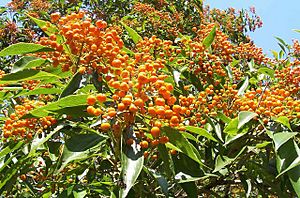Auranticarpa facts for kids
Quick facts for kids Auranticarpa |
|
|---|---|
 |
|
| Auranticarpa rhombifolia | |
| Scientific classification |
|
| Kingdom: | Plantae |
| Clade: | Tracheophytes |
| Clade: | Angiosperms |
| Clade: | Eudicots |
| Clade: | Asterids |
| Order: | Apiales |
| Family: | Pittosporaceae |
| Genus: | Auranticarpa L.Cayzer, Crisp & I.Telford |
| Species | |
|
See text |
|
Auranticarpa is a special group of trees that belong to the Pittosporaceae plant family. Imagine a family tree for plants – Auranticarpa is one branch! These trees are quite unique because all six types of Auranticarpa are found only in certain parts of Northern Australia.
Contents
Discovering Auranticarpa Trees
Auranticarpa is what scientists call a genus. A genus is like a small group of very similar plants or animals. All the plants in this group share many features. The Auranticarpa genus is part of a larger plant family called Pittosporaceae. This family includes many different kinds of flowering plants, often trees or shrubs.
Where Auranticarpa Trees Grow
These interesting trees love warm, wet places. You can find them growing in what are called "monsoonal forests." These are forests that get a lot of rain during the monsoon season, which is a time of heavy rainfall. They also grow at the "rainforest margins," which are the edges or borders of rainforests. This means they like places where there is plenty of moisture and a warm climate, typical of Northern Australia.
Types of Auranticarpa
There are six known species, or types, of Auranticarpa trees. Before scientists gave them their own special group, they were all thought to be part of another genus called Pittosporum. Here are the different kinds of Auranticarpa you might find:
- Auranticarpa edentata
- Auranticarpa ilicifolia
- Auranticarpa melanosperma
- Auranticarpa papyracea
- Auranticarpa resinosa
- Auranticarpa rhombifolia – This one is also known by the common names Hollywood or diamond-leaf pittosporum, because of its unique leaf shape.
See also
 In Spanish: Auranticarpa para niños
In Spanish: Auranticarpa para niños

